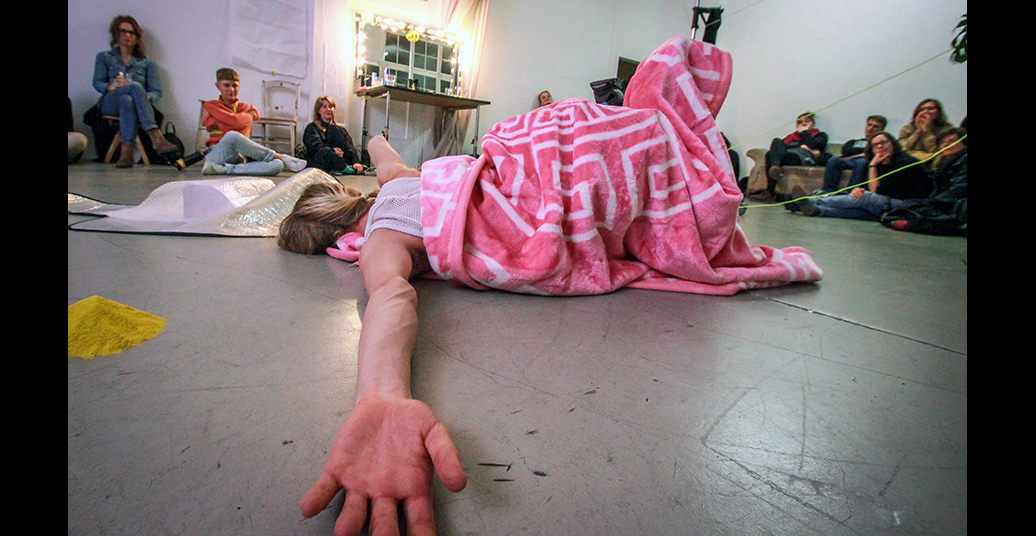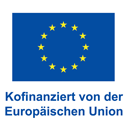Peter Scherrebeck Hansen, Snorre Hansen, and Katrine Staub share an open rehearsal at the end of their month at the Lause Residency for Art and Activism.
A bright pink, plushy blanket is stretched out like a rug near the corner of a long, large room. The sound of the ocean washes through the space. Just next to the pink blanket-rug is a large potted plant, along with other strange yet familiar home-things: a yoga mat, a laptop, pieces of bubble-wrap lovingly placed over cement blocks, little pyramids of spices and dirt resting on the floor. Many strings, tied from weighted objects on the floor, stretch up to the ceiling — a minimalist spider-web elegantly hovering above and around the space. From some of these strings, odd objects and food items hang in little transparent bags. Two lemons in a little sac dangle from one; close to the ceiling, a netted bag holding some wooden blocks is suspended; on the floor, there is a bag of potatoes and another bag of onions.
The three performers are dressed in bright colours and funky patterns, their jeans have the back pockets cut out, so cheeky bums and underwear peek out at us. Across their torsos are intricately tied strings upon which dangle a few more little bags containing funny collections of small objects. This joyously gender-queer trio introduce the evening as an “open rehearsal” and mention their research into creating “porous nests” — temporary homes, and spaces which feel safe enough to dance in, manifested in an increasingly precarious world.
They start the open rehearsal with music resembling the soundtrack to the video game SIMS. It’s not playing very loudly, so a particularly strange atmosphere is created. With soft and sincere smiles, they keep a close eye on each other as they improvise through the score for that evening’s rehearsal. They seem to be performing very much for each other. As they strut, dance, and shake in sometimes humorous ways, it’s always a negotiation, a silent communication, an entangled game of looking, listening, and responding. I feel like I’m witnessing the strange rites of an intimate animal-family.
Staub, Scherrebeck Hansen, and Hansen are sharing their work in the framework of the Lause Residency for Art and Activism, which means that this gentle, sweet open rehearsal is nestled into a broader, bigger narrative of great political import. There is a somewhat complex story behind this residency, which I’ll do my best to tell. Because like the strings woven through the performance space, it is entangled within the work of these performers.
In 2007 the city of Berlin sold Lause — the household collective at Lausitzerstraße 10 and 11 in Kreuzberg — to the Tækker Group, owned by wealthy Danish property investor, Jørn Tækker. He bought the building for 2.3 million Euros, and almost a decade later, in 2016, decided to sell it for 20 million Euros. This sale threatens to end 40 years of creative, self-organizing community culture, and displace the 170 people who live and work at Lause, made up of families, house-shares, small enterprises, and artist studios. Curiously, Jørn Tækker also happens to be a huge supporter of the arts in Denmark, and up until recently, had funded a residency allowing Danish artists to spend a month in Berlin. Not so many Danish artists were aware of Tækker’s activities as a landlord in Berlin, until this article highlighted the effect of gentrification on artists and creative spaces in the city, such as Lause. Tækker’s response to the article was to withdraw his funds and put an end to the residency for Danish artists in Berlin. Lause, meanwhile, responded in turn by getting in touch with Danish artists and creating a residency of their own.
In this way, the Lause Residency for Art and Activism was born, and it is within the context of this story that Staub, Scherrebeck Hansen and Hansen, all of whom hold Danish nationality, found their way to Lause. The residency ingeniously and generously provides an alternative platform for Danish artists in Berlin, whilst at the same time, fosters important connections and develops solidarity between Danish and German artists. Together, they can draw attention to the more global issue of gentrification, displacement, and the commodification of the arts. Although the situation at Lause is still incredibly uncertain, and negotiations take a seeming eternity to play out, events like this are making real differences to the cause by calling attention to Tækker’s business and public image. This, in turn, gives the folks at Lause some leverage with Tækker, who has, at last, conceded to negotiate with them.
These broader themes of gentrification and the very specific battle between Tækker and Lause both frame this residency. Although artists are free to make whatever kind of work they wish to during their stay, one can pick up on the ways in which the container affects the contents. The strings across the space speak to our collective entanglement. The precariously hung bags containing emblems of domesticity evoke the precarious state of both the building and the home-lives of artists all over the world. The very visible closeness of the group, as they move the piece forward through an unspoken yet unified process of choice-making, hints at the radical power of collective action and self-organisation.
For the after-talk, residents and activists based at Lause make up the bulk of the audience. We gather around, cosy and intimate, discussing the work as well as the context of the work. Topics such as cruising, birds-of-paradise, chosen-kin, and process — both legal and artistic — make their way into the discussion, and, for me, it is a moment where things seem to come together. The Lause folks talk openly and calmly despite the threat of gentrification and the end of an era looming over their heads. There is a certain positivity, an upliftment, even a joy in the room.
On my way home, I think about the relationships between community-making and art-making. I consider the ways in which both of these types of labour require a kind of doggedness — a commitment to the mundane day-to-day in which you chip away at the often unglamorous tasks involved in building the kind of world you want to live in. Endless emails, and often very frustrating meetings where everyone present attempts to think together — this is the work of making change. Maybe sometimes, making a little a nest where you can dance for your friends is the most radical thing you can do to defend your joy and tend to your hope. In this way, perhaps you can continue to do your work. I certainly hope the folks at Lause are able to continue with theirs.




